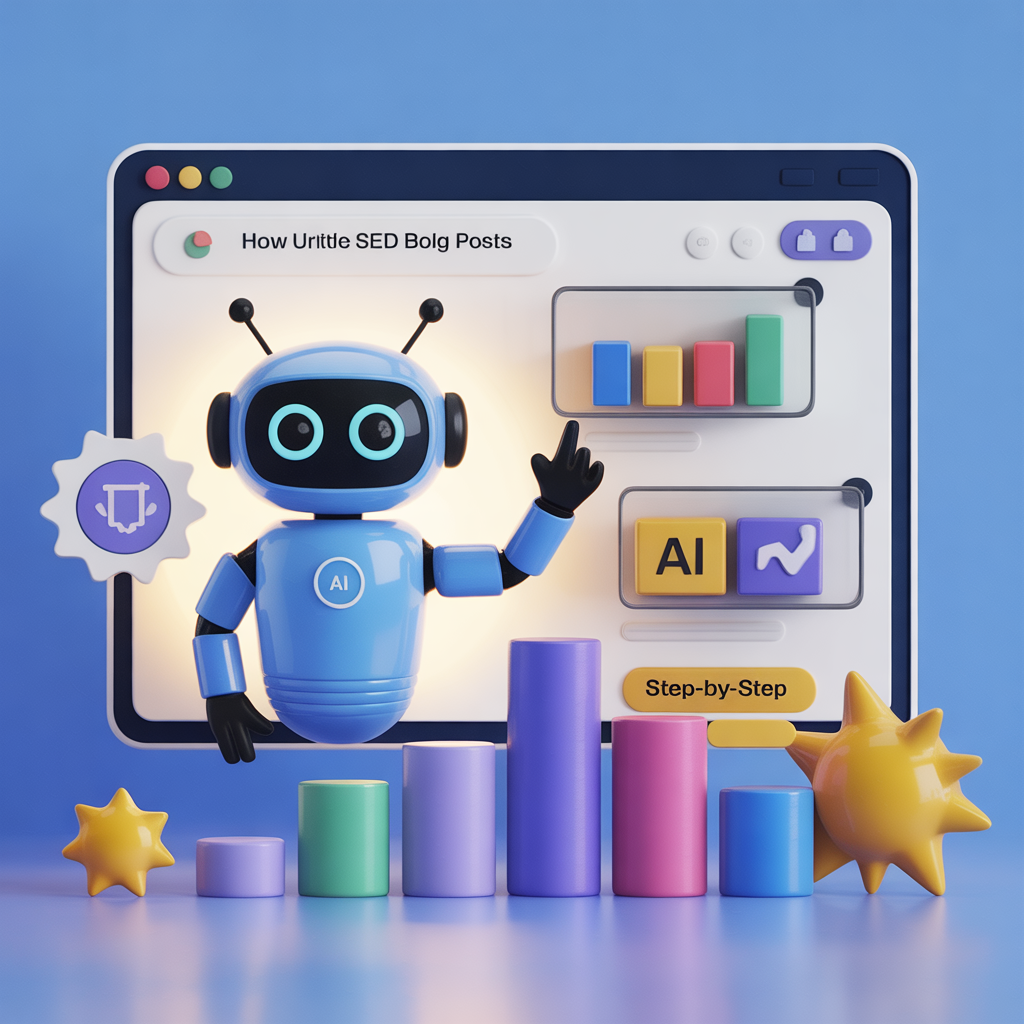In 2025, content is still king — but AI is the new crown.
The days of spending hours researching keywords, structuring paragraphs, and optimizing every blog post manually are gone.
Now, AI can write SEO-optimized blog posts in minutes — complete with headings, keywords, and natural flow.
But here’s the catch:
Only a few people actually know how to guide AI the right way to create blogs that rank on Google and sound human.
In this guide, we’ll show you how to write SEO-friendly blogs using AI step by step, including keyword research, outline generation, writing prompts, and optimization tricks to attract organic traffic.
🚀 Why AI Blog Writing Is the Future of SEO
If you’ve ever struggled to write consistent, SEO-focused content — AI can be your best assistant.
Here’s what makes AI blog writing so powerful:
✅ Speed: AI can produce a 1,000-word blog in minutes.
✅ Optimization: It understands SEO keywords and readability.
✅ Scalability: You can publish 10 blogs in the time it used to take for one.
✅ Affordability: No need for multiple freelance writers.
✅ Consistency: Tone, style, and structure remain uniform.
In short, AI turns the blogging process from a slow, manual effort into a smart, automated growth system for your website.
🔍 Step 1: Choose the Right Keyword (Start with Search Intent)
The first rule of SEO blogging: write for people first, search engines second.
Start by identifying a specific keyword or question your audience is searching for.
Example tools:
- Google Keyword Planner
- Ahrefs
- SEMrush
- Ubersuggest
- Or even ChatGPT / AI tools for keyword brainstorming
For instance, if your niche is AI writing tools, search terms like:
- “AI blog writer free”
- “how to write SEO blogs with AI”
- “best AI content writer for bloggers”
Once you pick your target keyword, your AI writer can automatically include it naturally throughout the post — in titles, headings, and the body.
🧩 Step 2: Generate an SEO Blog Outline with AI
AI tools can help you create optimized outlines in seconds.
Prompt example:
“Create an SEO-optimized blog outline for the topic ‘How to Write SEO-Friendly Blogs with AI.’ Include headings (H2, H3) and subtopics.”
You’ll get something like:
- Introduction
- Why AI is the Future of SEO Writing
- Step-by-Step Guide
- Choose the Right Keywords
- Generate AI Outlines
- Write Content with Natural Flow
- Optimize for Readability
- Add Meta Details
- Tools for AI Blog Writing
- Common Mistakes to Avoid
- Final Thoughts
This structure gives your post clarity, keyword placement, and a perfect flow.
✍️ Step 3: Let AI Write Your First Draft (with Smart Prompts)
Here’s where the magic happens.
Use your AI writer to generate content section by section instead of dumping one big prompt.
That’s how you get focused, high-quality paragraphs.
Example prompt:
“Write an engaging 150-word introduction for a blog titled ‘How to Write SEO-Friendly Blogs with AI.’ Make it conversational and keyword-rich.”
Then:
“Write a 200-word section explaining how AI improves SEO content creation.”
Break your blog into manageable chunks — AI performs best this way.
💡 Pro tip: Always edit your AI draft. Add your tone, examples, and transitions. That’s what keeps it human and Google-friendly.
⚙️ Step 4: Optimize for Readability and SEO
Once your AI blog draft is ready, it’s time to polish it.
Here’s a checklist:
| Optimization Step | Goal | Tool or Method |
|---|---|---|
| Use short paragraphs (2–3 lines) | Improve mobile readability | Manual edit |
| Add H2 & H3 subheadings | Structure and keyword placement | AI/Manual |
| Insert target keyword every 100–150 words | Maintain SEO density (1–2%) | Grammarly / SurferSEO |
| Add transition words (e.g., however, therefore) | Smooth reading | AI rewrite prompt |
| Include bullet points/lists | Easy scanning | Manual |
| Internal linking | Boost authority | Link to other pages |
| Add meta title & description | Help search engines understand content | Manual |
The goal isn’t to “stuff keywords” — it’s to write naturally optimized content that both people and Google love.
💡 Step 5: Add Meta Title, Description, and Tags
Your AI tool can also generate perfect SEO metadata.
Prompt examples:
“Write an SEO meta title (under 60 characters) and meta description (under 150 characters) for this blog.”
Example Output:
- Meta Title: How to Write SEO-Friendly Blogs with AI (2025 Guide)
- Meta Description: Learn how to write SEO blogs with AI tools. Step-by-step guide for keyword research, optimization, and ranking tips.
This step alone improves your click-through rate (CTR) by up to 30%.
⚡ Step 6: Optimize Your Blog for Google’s 2025 Standards
Google’s SEO standards are evolving, and AI can help meet them easily.
Here’s what matters most in 2025:
✅ EEAT (Experience, Expertise, Authoritativeness, Trustworthiness)
Even if AI writes your post, include:
- Your name or company as the author
- Real examples or data
- Links to credible sources
✅ Search Intent Matching
Ensure your blog answers what the user really wants — not just what keywords say.
✅ Natural Tone & Engagement
AI tools can mimic conversational tone (like this one), keeping users engaged longer — a positive SEO signal.
🧰 Step 7: Use AI Tools for Continuous SEO Growth
Here are some of the most powerful ways to combine AI + SEO:
| AI Tool Type | Function | Example Use |
|---|---|---|
| AI Blog Writers | Draft entire blog posts | Generate 1,000+ word articles |
| Keyword Assistants | Suggest trending topics | “Find trending AI writing keywords for October 2025” |
| SEO Optimizers | Analyze keyword density | Improve ranking chances |
| Image Generators | Create blog visuals | “Generate an AI image for productivity blog” |
| Title/CTA Generators | Write catchy blog headlines | “Create 5 SEO-friendly blog titles for AI content writing” |
You don’t need to use all of them — start with one AI writer and expand as your content grows.
⚠️ Common Mistakes to Avoid When Using AI for SEO Blogs
Even powerful AI tools won’t help if you use them the wrong way.
Avoid these common pitfalls:
❌ Copy-paste without editing. Always review and add human touch.
❌ Overstuffing keywords. Google can detect unnatural repetition.
❌ Ignoring structure. Long blocks of text reduce readability and ranking.
❌ Skipping internal links. Connect related articles to boost authority.
❌ Not updating blogs. Refresh older posts every few months for new trends.
Remember: AI gives speed, but your expertise gives direction.
📈 Example: AI-Generated SEO Blog Snippet
Here’s a real example of how an AI might write a short blog snippet for SEO:
“Writing SEO-friendly blogs with AI in 2025 is easier than ever. With AI-powered tools, you can generate keyword-rich articles that attract readers and rank faster. The secret lies in guiding AI with the right prompts and optimizing your content for both humans and algorithms.”
Notice how natural, keyword-rich, and readable it sounds? That’s the sweet spot.
🧩 Advanced Tip: Create an AI Blog Content Calendar
Once your AI writing system is set, scale your blog strategy.
- List 30 keywords in your niche.
- Ask AI to generate blog titles for each keyword.
- Schedule 2–3 blogs per week.
- Use automation tools (like Notion, Trello, or Airtable) to track publication.
In 30 days, you’ll have a full SEO content library — built efficiently and affordably with AI.
❓ FAQs About AI SEO Blog Writing
1. Can AI really write SEO blogs that rank?
Yes. When guided properly with keywords, headings, and clear intent, AI-generated blogs can rank alongside human-written ones.
2. Is AI content considered duplicate or spammy?
No — if you edit and personalize it. Google rewards originality and expertise, not just who typed the words.
3. How long should an SEO blog be?
Typically 1,000–1,500 words. Longer blogs perform better when they provide detailed, structured value.
4. Can AI also write product descriptions and landing pages?
Absolutely. The same technology can create all types of web content optimized for SEO.
🏁 Final Thoughts: AI + SEO = Unlimited Growth
AI isn’t here to replace writers — it’s here to empower them.
It helps you move faster, publish consistently, and stay ahead in search rankings.
So whether you’re a small business owner, a marketer, or a blogger — you can now create SEO-rich blogs effortlessly and focus on growing your business.
The secret isn’t just using AI — it’s learning how to guide it strategically to produce human-quality content at AI speed.
Start today.
Let AI handle the writing while you focus on what truly matters — your ideas, your voice, and your audience.


